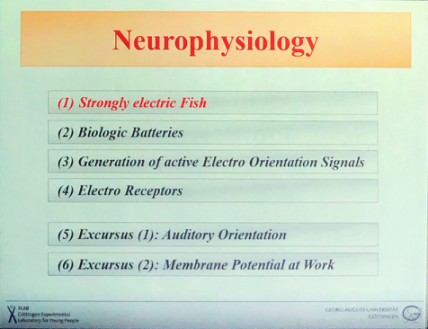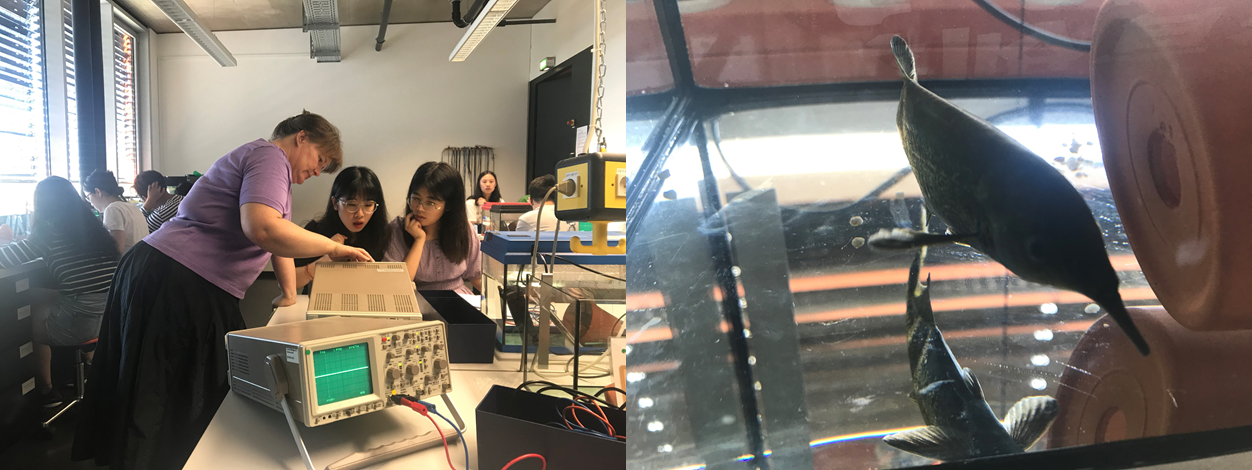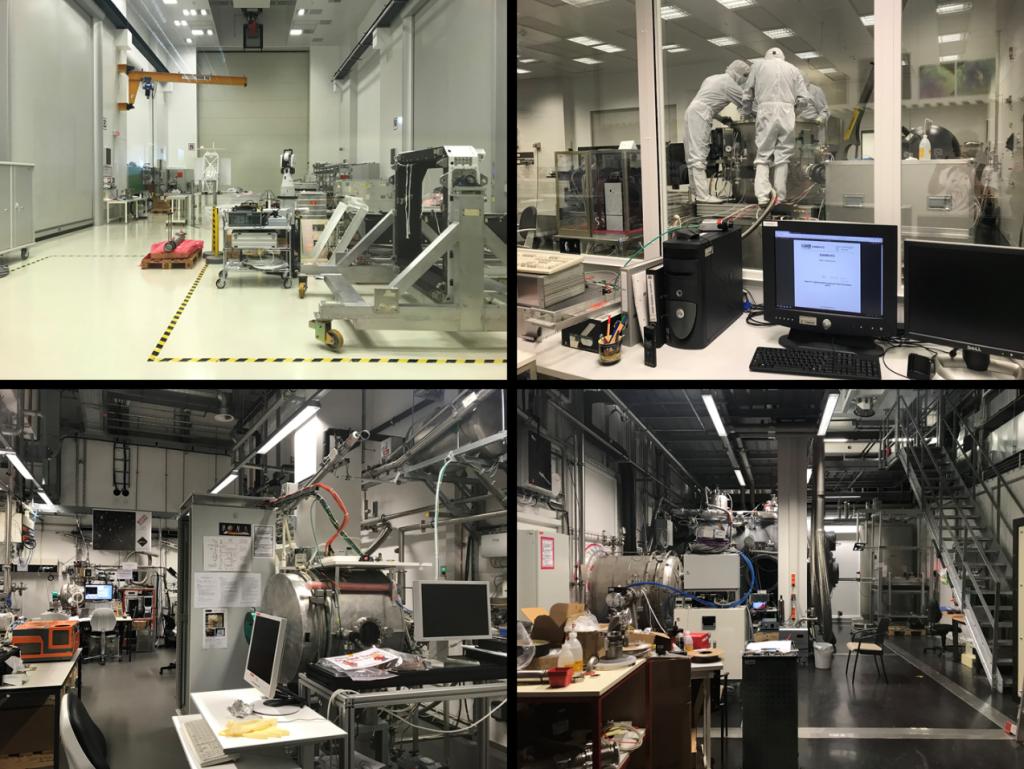RAYBET雷竞技
2019暑期欧洲贝时璋菁英班研学夏令营日志
Day 12: 推开神经生理学大门
掐指一算,今天是我们在X-lab学习的第四天。在学习两天分子与生化实验技术之后,终于在今天,Barbara Ritter教授带我们推开了神经生理学的大门。

图1. 今日课程大纲
与前几天相同,简单的早餐过后,同学们一起乘车到达位于X-lab四层的神经科学教室,随即便开始今天的课程。Barbara Ritter教授先用自然界中某些鱼类放电的现象引出今天的主题——神经生理学(neurophysiology)。电鳗(electric eel)可以放出高达800V电压的电,达到我国民用电路电压的约4倍。若不小心被正在放电的电鳗击中,我们的神经、肌肉、心脏等很多器官、系统都会受到严重的损伤。而这些能够放电的鱼类,对人类并不是百害而无一利的。利用它们放电的特性,人们可以将其用于痛风的治疗。
同学们都被Barbara Ritter教授精彩而有趣的例子吸引住。接下来Barbara Ritter教授给大家着重讲授了神经细胞(可视为“生物电池”)的生理学概念:静息电位与动作电位。对于神经细胞来说,膜电位可视为电压,流动的离子为电流,磷脂双层膜和离子通道为电阻,这样便形成了最简单的电路。

图2. 在实验过程中,Barbara Ritter教授解答同学们提出的问题
随后,课程进入到了实验环节。首先,Barbara Ritter教授向同学们介绍了今天要用到的实验动物:elephant fish。elephant fish是一种可以放电的鱼类,它能够通过感知周围电场的变化,获得周围环境和物体的信息,从而对自身的运动进行指导和调整。在Barbara Ritter教授的指导下,每个小组都成功地从大鱼缸中取了一条鱼到自己的小鱼缸里,以便后续实验之用。根据讲义,大家设置好示波器参数,并将两根电极连接到鱼缸的两端,实验的准备工作就完成了。
午饭后,同学们回到实验室继续进行实验操作。通过观察示波器上显示的波形以及鱼的运动特征,同学们找到了两者的对应关系,发现了elephant fish的电学特征:1、发电器官在尾部。2、发电时顺势电压可达到300mV。3、头部为正极,尾部为负极。随后,Barbara Ritter教授向我们提出了两个科学问题,引导我们进行更深层次的思考:1、示波器上总显示相同的波形,那么,发电细胞(electrocytes)工作的细胞生物学机制是什么?2、发电细胞的活动高度统一,这背后有哪些可能的机制?通过思考与讨论,同学们和Barbara Ritter教授一同解开这两个问题。

图3. Barbara Ritter教授板书——对两个科学问题的探讨
毫无疑问,自夏令营开始以来,今天的课程绝对是最有趣、最有启发性的。同学们学习了全新的知识和实验技能,收获满满!
离开X-lab之后,同学们来到马克斯-普朗克太阳系研究所(MPS)进行参观。雄伟壮丽的星球图像,神奇精巧的航天仪器,每一处都让我们感受到了宇宙的魅力。有幸的是,我们还看到研究者们正在对来自太空的样品进行实验。

图4. 参观马克斯普朗克太阳系研究所
充实而疲倦的一天即将结束,在回程的路上,我不禁思考:宇宙之大,人类却知之甚少;地球上物种众多,人类对它们的了解也并不完全。站在宇宙的角度看,地球是渺小的,而人类,就显得更微不足道了。这种渺小的感觉,还体现在我们对世间万事万物的认知上,有太多的重要的科学问题,我们至今都无法给出答案。我们,作为渺小的个体,也许无法解开上帝创造世界是设置的谜题。但通过对未知的努力探求,我们或许能稍稍拓宽一点人类认知的边界,这将带给我们长久的精神上的满足。我想这正是我们活着的意义所在。
Today is the fourth day we studying at X-lab. After studying two days of molecular and biochemical experiments, finally, today, Professor Barbara Ritter took us to open the door of neurophysiology.

After a simple breakfast, we students arrived in the neuroscience classroom on the fourth floor of the X-lab and started the course today. Professor Barbara Ritter first used the phenomenon of discharge of certain fish in nature to bring out today's theme, neurophysiology. The electric eel can discharge up to 800V, which is about 4 times the voltage of our national circuit. If you accidentally hit a battery that is being discharged, many organs and systems such as nerves, muscles, and heart will be seriously damaged. And these fish that can be discharged are not harmful to human beings. Using their discharge characteristics, one can use it for the treatment of gout.
We were attracted by the wonderful and interesting examples of the professors. Next, Professor Barbara Ritter gave a lecture on the physiological concepts of nerve cells (which can be regarded as "bio-batteries"): resting potential and action potential. For nerve cells, the membrane potential can be regarded as voltage, the flowing ions are current, and the phospholipid bilayer membrane and ion channel are resistance, thus forming the simplest circuit.

Subsequently, the course entered the experimental session. First, Professor Barbara Ritter introduced the experimental animals to be used today: elephant fish. Elephant fish is a kind of fish that can be discharged. It can guide and adjust its own movement by sensing the changes of the surrounding electric field and obtaining information about the surrounding environment and objects. Under the direction of Professor Barbara Ritter, each team successfully took a fish from the big aquarium into its own aquarium for subsequent experiments. According to the lecture, everyone set the oscilloscope parameters and connected the two electrodes to the ends of the aquarium. The preparation for the experiment was completed.
After lunch, we returned to the lab to continue the experiment. By observing the waveforms displayed on the oscilloscope and the motion characteristics of the fish, we found the correspondence between the two and found the electrical characteristics of the elephant fish: 1. The power generation organ is at the tail. 2. The homeostatic voltage can reach 300mV during power generation. 3. The head is positive and the tail is negative. Later, Professor Barbara Ritter asked us two scientific questions to guide us to think deeper: 1. The oscilloscope always shows the same waveform. So, what is the cell biology mechanism of electrocytes? 2. The activities of power generation cells are highly unified. What are the possible mechanisms behind this? Through thinking and discussion, we students and Professor Barbara Ritter solve these two problems together.

There is no doubt that today's courses are definitely the most interesting and inspiring since the beginning of the summer camp. We have learned new knowledge and experimental skills, and the harvest is full!
After leaving X-lab, we came to the Max-Planck Institute for Solar System (MPS) to visit. The majestic image of the planet, the magical and exquisite aerospace instrument, every place makes us feel the charm of the universe. Fortunately, we have also seen researchers experimenting with samples from space.

The full and tired day is coming to an end. On the way back, I can't help thinking: the universe is big, but humans know very little; there are so many species on earth, and humans do not understand them completely. From the perspective of the universe, the earth is small, and human beings are even more insignificant. This insignificant feeling is also reflected in our understanding of everything in the world. There are too many important scientific problems that we haven’t been able to give an answer so far. We, as insignificant individuals, may not be able to solve the puzzle which created by God. But through the exploration of the unknown, we may be able to broaden the boundaries of human cognition a little, which will bring us long-term spiritual satisfaction. I think this is the meaning of life.